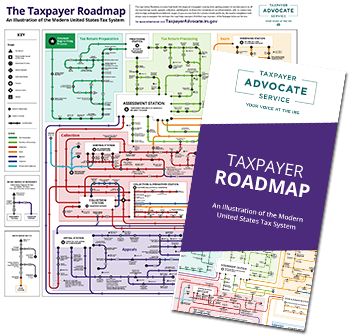Published: | Last Updated: May 31, 2023
Notice CP504
Final Notice — Balance Due
View our interactive tax map to see where you are in the tax process. It could help you navigate your way through the IRS.
View our interactive tax map to see where you are in the tax process. It could help you navigate your way through the IRS.

The Notice CP504 (also referred to as the Final Notice) is mailed to you because the IRS has not received payment of your unpaid balance.
This notice or letter may include additional topics that have not yet been covered here. Please check back frequently for updates.
The Notice CP504 (also referred to as the Final Notice) is mailed to you because the IRS has not received payment of your unpaid balance and tells you how much you owe, including additional penalties and interest, when it’s due, and how to pay before further collection action takes place.
This notice is your Notice of Intent to Levy (Internal Revenue Code Section 6331 (d)). If the IRS does not receive the amount due within 30 days from the date of this notice, the IRS can levy your state tax refund. IRS may also serve a Disqualified Employment Tax Levy or a Federal Contractor Levy, as explained in the enclosed Publication 594, The IRS Collection Process. In most other situations, before the IRS issues a levy on your property or rights to property, IRS will send you a notice that gives you the opportunity to request a Collection Due Process (CDP) hearing, unless you have already received one.
The Notice CP504 provides various options on how you can pay the balance due (e.g., via electronic payment options on Pay Your Taxes on IRS.gov or via check or money order payable to the United States Treasury).
If you can’t pay the full amount by that date, you need to figure out what payment options might work for your situation, and act to set up a payment plan or discuss other ways to pay off your balance. Being proactive in addressing the tax debt may prevent additional penalty and interest charges and eliminate the need for the IRS to take action to collect the balance. For specifics, see I got a notice from the IRS.
If you choose not to respond to the Notice CP504, the IRS may send you a collection notice requiring payment with your right to request a Collection Due Process hearing (e.g., your appeal rights via a Notice of Intent to Levy and Your Notice of a Right to a Hearing), before taking further action to collect the balance due. This further collection action could include the IRS levying or seizing your wages and other income, bank accounts, business assets, personal assets (including your car and home), retirement accounts (including the Thrift Savings Plan), Alaska Permanent Fund Dividends, and Social Security benefits up to the amount the taxpayer owes.
If you have not paid the debt already, a federal tax lien has arisen as a claim against all your property. If you don’t pay the amount due immediately or make payment arrangements, the IRS can file a Notice of Federal Tax Lien (NFTL) publicly establishing their priority with your creditors or the IRS may levy (subject to any applicable Collection Due Process rights). If the IRS files the NFTL, it may be difficult to sell or borrow against your property.
This notice also explains the possible denial or revocation of your United States passport. Visit Revocation or Denial of Passport in Case of Certain Unpaid Taxes for further information.
For specifics on your particular notice, visit Understanding your IRS Notice or Letter.
You have a balance due on your tax account, and you have not paid it. The Notice CP504 (also referred to as the Final Notice) is being sent to you to let you know how much you owe, including additional penalties and interest, when it is due, and how to pay it before further collection actions take place.
The first thing to do is to check the return address to be sure it’s from the Internal Revenue Service and not another agency.
If it’s from the IRS, the notice will have instructions on how to respond to the notice received and who to contact. If the notice is not from the IRS, visit I Got a Notice From the IRS for further details.
Next, you should read the notice carefully. It explains how much you owe with additional penalties and interest when your payment is due, and your payment options, including steps to take before further collection actions take place.
If you disagree with the notice, call the IRS at the toll-free number located towards the top of the second page of your notice. Please have your paperwork (such as cancelled checks, amended return, etc.) ready when you call. See also Publication 5, Your Appeal Rights and How to Prepare a Protest If You Don’t Agree.
If you don’t agree with the intent to levy, you have the right to request an appeal under the Collection Appeals Program (CAP) before collection action takes place. If you want to file an appeal, call 800-829-0922 or send the IRS a Form 9423, Collection Appeals Request, to the address at the top of the notice. Call if you have any questions. For more information about your appeal rights, see Publication 1660, Collection Appeal Rights, enclosed with the notice.
If you believe you have an acceptable reason for interest or a penalty to be removed or reduced, you may complete Form 843, Claim for Refund and Request for Abatement, or send a signed statement to the IRS explaining your reason why. For specific instructions, see Notice 746, Information About Your Notice, Penalty and Interest.
If you can’t pay the full amount by that date, you need to figure out what payment options might work for your situation, and contact the IRS to set up a payment plan or discuss other ways to address your balance.
Being proactive in addressing the tax debt may prevent additional penalty and interest charges and eliminate the need for the IRS to take action to collect the balance.

Understanding your notice or letter
For more specifics on your notice or letter, visit Understanding your IRS Notice or Letter on IRS.gov or review the information below directly related to your notice or letter.
Additional Resources
Get Help topics
Browse common tax issues and situations at TAS Get Help
Your options
If you think you’ll have trouble paying your taxes, it’s helpful to know what your options are to address your tax debt.
If you still need help
The Taxpayer Advocate Service is an independent organization within the IRS that helps taxpayers and protects taxpayers’ rights. We can offer you help if your tax problem is causing a financial difficulty, you’ve tried and been unable to resolve your issue with the IRS, or you believe an IRS system, process, or procedure just isn’t working as it should. If you qualify for our assistance, which is always free, we will do everything possible to help you.
Visit www.taxpayeradvocate.irs.gov or call ![]() 1-877-777-4778.
1-877-777-4778.
Low Income Taxpayer Clinics (LITCs) are independent from the IRS and TAS. LITCs represent individuals whose income is below a certain level and who need to resolve tax problems with the IRS. LITCs can represent taxpayers in audits, appeals, and tax collection disputes before the IRS and in court. In addition, LITCs can provide information about taxpayer rights and responsibilities in different languages for individuals who speak English as a second language. Services are offered for free or a small fee. For more information or to find an LITC near you, see the LITC page on the TAS website or Publication 4134, Low Income Taxpayer Clinic List.
Related Letters and Notices
Notice CP504, Final Notice